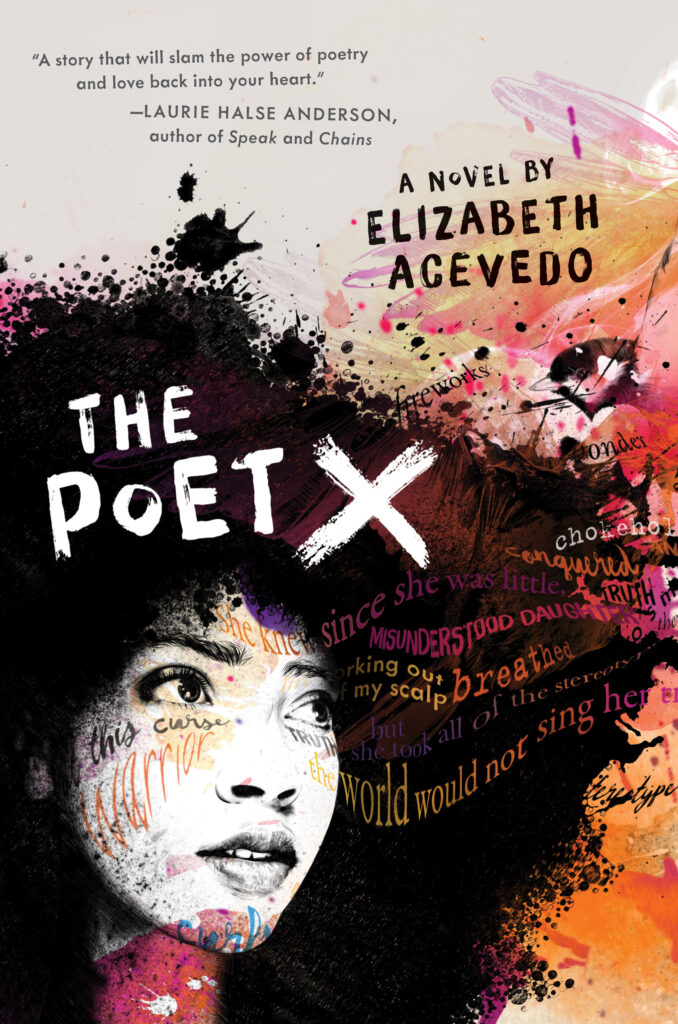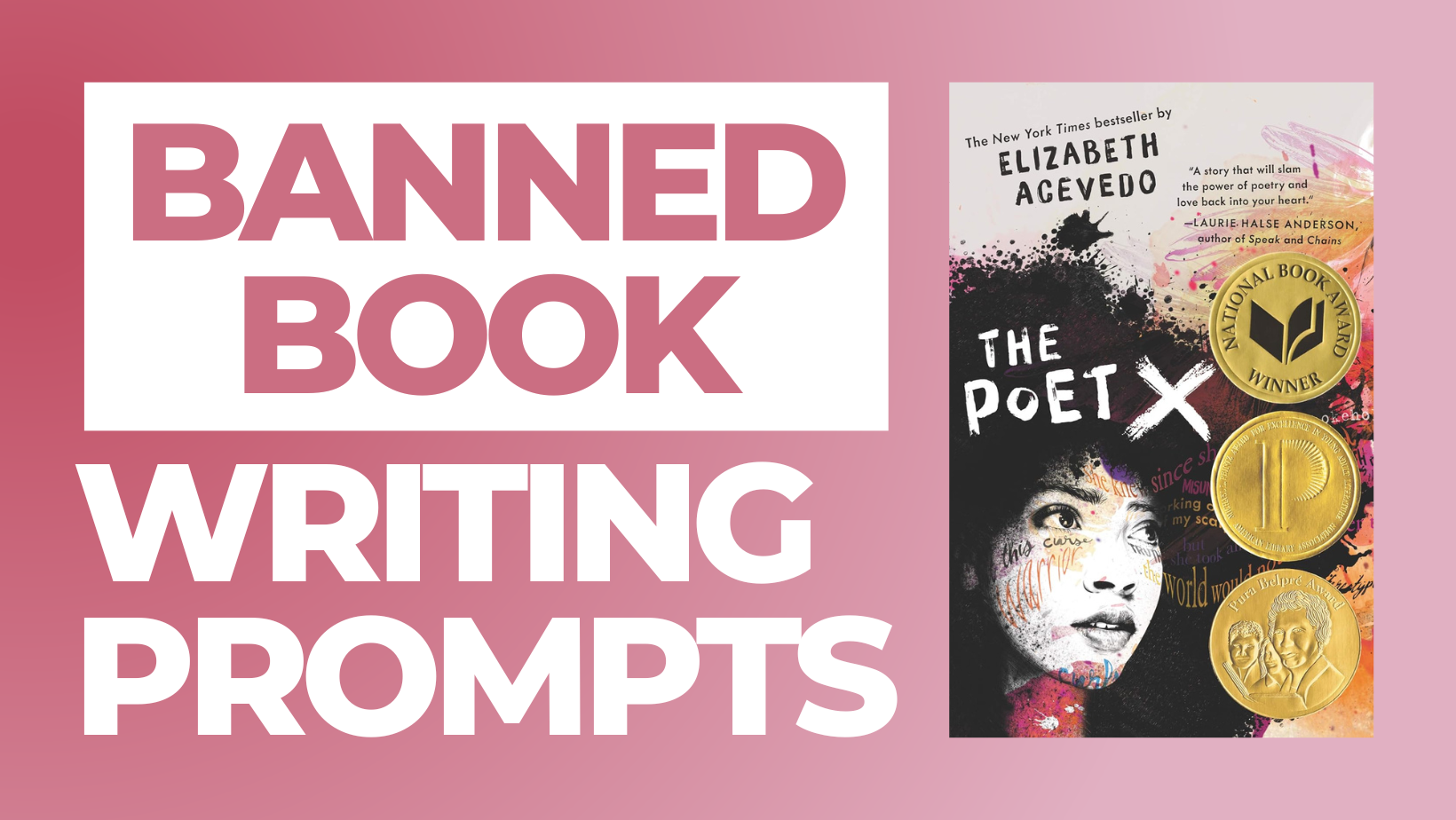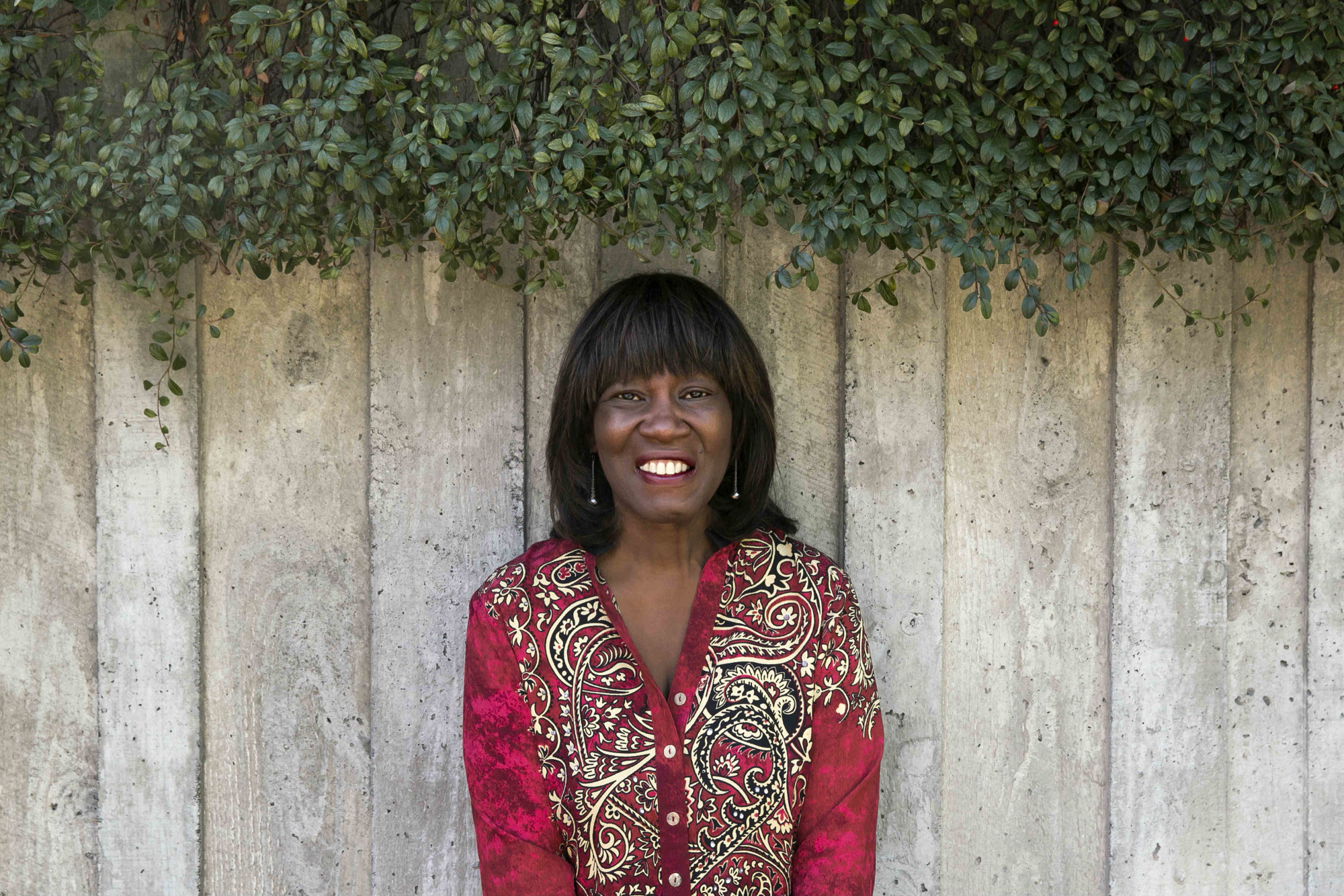In Banned Book Writing Prompts, a new series in Teachers & Writers Magazine, we aim to push back against the growing movement to censor what students can read and to show what happens when we enthusiastically embrace banned works rather than fear them. You can read an introduction to this series by Susan Karwoska here, and you can find more Banned Book Writing Prompts here.
Also in the magazine: “The Braver We Become: A Conversation with Elizabeth Acevedo.”
I had been teaching “Literature for Young People” at Brooklyn College for several years, and I needed to shake up the syllabus. I asked one of my graduate students to recommend a contemporary YA novel, and he immediately suggested The Poet X. “I think you’ll really love it,” he said, and with this encouragement, I dove in.
It didn’t take long for me to become immersed in Elizabeth Acevedo’s gorgeous, pitch-perfect novel-in-verse. Her protagonist, Xiomara Batista, is a high school sophomore in Harlem navigating conflicting feelings about religion, love, family, and self-expression. The typical plot points of a coming-of-age story appear, and in Acevedo’s masterful hands, every twist and turn feels genuine. I devoured it in two days and immediately swapped it into my syllabus for the following semester at Brooklyn College.
Could you imagine if, at 13, you read a book about a young Hispanic girl navigating through almost exactly the same issues as you did? All that anger, frustration, confusion, and insecurity would have been maybe a bit easier to work through.
I was especially moved by the vivid descriptions of the poetry classroom as a sanctuary and creative laboratory. Acevedo describes this space—a space I cherish—with great authenticity. Over the years I’ve seen what poetry can do, the way it can alchemize young people and help bring out their voices. I was excited to see this represented in The Poet X.
Acevedo’s dedication, which precedes the opening poem, is “To Katherine Bolaños and my former students at Buck Lodge Middle School 2010–2012, and all the little sisters yearning to see themselves: this is for you.” With this, Acevedo makes one of her intentions explicit: to offer a “mirror” to young women of color who have been underrepresented in literature for young people for so long. I’ve been teaching The Poet X consistently for several years now, and my students’ responses provide the most moving and eloquent testimony about the importance of this reflection. I’ve asked and received permission from two students to share excerpts from their writing.
In her reading response titled “Sisters with Voices,” Jessica Sheppard writes:
Ahhh, another home run for the brown girls who preferred sneakers over sandals and open mouths with closed fists. Xiomara feels like a home girl I knew growing up, one who my mom wouldn’t have wanted me hanging out with because, “we cause trouble when we’re together.” But I sneak around with her anyway, because I need her. I need to know that there are other girls out there who take a lot of hits and talk a lot of shit. I need to feel her fear, so that I may give myself permission to acknowledge my own. I need to see her tears, because I need proof that it’s okay for strong girls to cry. More importantly, I need to know that if you do the tears won’t melt the tough shell that took so long to build in the first place. Xiomara is my friend, my sister. We talk on the phone and muse about all of things we see and want and hope to have for ourselves. We push past one another’s protective exteriors to open ourselves up to what we know will be a tender, sometimes painful exchange of stories, experiences, laughs, and questions about who we are, where we have been, and the fact that neither of us is really sure where we’ll go.
[. . .]
Xiomara’s is a story that speaks to so many people’s experiences, but I’d like to think that this coming-of-age tale is especially triumphant to women of color who are bold and bright enough to speak, even before they’re spoken to.
Another student, Briana Pascascio, a graduate student working on her degree in education, created a final project about The Poet X in the form of an extended multimedia letter to her younger self. In an introductory passage, she writes:
But could you imagine if, at 13, you read a book about a young Hispanic girl navigating through almost exactly the same issues as you did? All that anger, frustration, confusion, and insecurity would have been maybe a bit easier to work through. Maybe, you would have gained your confidence years earlier or a better way to express yourself beyond just listening to music and coded journaling. Well, I’d like to share something with you. You discover (and are also assigned) a verse named The Poet X written by Elizabeth Acevedo and, in two days, you complete the book and all your 28-year-old brain could think was, “Wow! This was me.” And your mind reeled with how different you might have felt if this novel was written 10 years earlier and mom borrowed the book from the library for you to read. Through reading this book, you discover the 13-year-old you who, in a way, still needed this book. Then you realize that you will make sure you have all kinds of literature in your future English classroom that causes all the different walks of life in your class to feel seen. But, to circle back to you, who realized how much you still needed this novel, I will share with you the moments in the novel you needed the most.
These beautiful testimonies demonstrate the power of Acevedo’s story to inspire, to encourage, to comfort, and to summon inner reserves of strength and creativity. You also can see how Acevedo’s writing provides a platform for student writing. Like all great art, it quickens our own creative impulse to act and create in response.
The idea of banning a book as beautiful as this one, as necessary as this one, feels outrageous to me. As in: rage-inducing, appalling. Since I first included The Poet X on my syllabus, students have received this book as a balm, a blessing, and a lifeline. Again and again they say, this is a book that would have made the younger me feel less alone, more empowered. May those of us in the position of sharing books like these offer them to the readers who need them most.

Writing Prompt 1
The Gaps Between Drafts: Encouraging Creativity & Authenticity
Given that Elizabeth Acevedo was once a middle-school teacher, and to this day leads writing workshops with young people, I think the writing prompts included in The Poet X are all worth sharing. In five instances throughout the book, we encounter a writing prompt given by Xiamora’s English teacher, Ms. Galiano. First we read the “rough draft” of Xiamora’s response to the assignment, and then we see her final draft, what she “actually turns in.” Acevedo offers this glimpse into the ways in which students alter, erase, or flatten their voices into a form that feels more acceptable, more “teacher friendly.” By offering the unfiltered “rough draft” beside the more formal and decidedly less lively “final draft,” we see this code-shifting process play out.
Take a look at one or more of Xiomara’s rough drafts and compare them with the accompanying final draft: Have you noticed a similar dynamic playing out in your own writing? How might your writing look, and feel, and sound, if you were given the permission to be more yourself or more creatively free? What is the line between code-shifting and self-censorship?
Following Xiomara’s example, respond to one of the writing prompts below, from The Poet X, with a “rough” version free of any constraints whatsoever, and a “final” version that conforms to your perceived preferences of a teacher or professor. Then compare the differences between the two as a means of exploring how code-shifting can limit creativity.
Assignment 1: Write about the most impactful day of your life.
Assignment 2: Last Paragraphs of My Biography
Assignment 3: Describe someone you consider misunderstood by society.
Assignment 4: When was the last time you felt free?
Assignment 5: Explain Your Favorite Quote
Writing Prompt 2
Making “Place” Pop on the Page
Read the very first poem in the book, “Stoop Sitting,” and notice how Acevedo evokes the setting through vivid description, or what I call with my younger students, “delicious details.” What lines create images in your mind?
Now think of a place you’ve lived or a place you know well, whether it’s your own block or stoop, or some outdoor spot of your choice. A meditation can be helpful here: try closing your eyes and envisioning what you see, hear, smell, and feel, followed by a free-write to gather these impressions, in note form, on the page. Set a timer for 7–15 minutes and write a draft of a poem using “Stoop-Sitting” as a model. If you prefer more structure, you can begin each stanza with some or all of Acevedo’s verbs:
I scope out . . .
Peep . . .
Listen to . . .
Laugh at . . .
Shake my head as . . .
Writing Prompt 3
“Let’s Talk About Line Breaks!”
After teaching The Poet X at Brooklyn College for the first time, I reached out to Elizabeth Acevedo for an interview with Teachers & Writers Magazine. Here is a short excerpt from one exchange:
Matthew: When reading The Poet X, I was struck by your line breaks and the way you negotiate the page. Do you have any strategies for teaching that level of craft with students?
Elizabeth: This is my favorite question. I’m like, “Let’s talk about line breaks!”
What follows this exchange is a helpful consideration about the various elements that influence a poet’s placement of line and stanza on the page, including pacing, breath, and emphasis. When I was first writing free verse poems, I wondered about these elements of craft and hungered for opportunities to explore them, and to this day, I enjoy examining the effects of spacing and enjambment with my students.
To start, take some time to explore a few of the poems in The Poet X where the line breaks create noticeable effects. For example, you might begin with a quieter example in “Warmth,” a poem about Xiomara holding hands with her crush, Aman. Read the poem aloud to demonstrate the subtle effects of the spacing in these lines:
We are silent the whole walk.
Without words we are in agreement
that we’ll walk as far as we can this way:
my hand held in his held
in his coat pocket. Each of us keeping
the other warm against the quiet chill.
When I recently discussed this poem with my class at Brooklyn College, one student noted the way the alliterative “w” brings emphasis to the intimacy of these two young individuals who are beginning to become a “we.” Then I asked: what do we make of the additional spaces in the line beginning “my hand”? Someone pointed out that it slows the pace and makes the reader focus in on the held hands. Another observed that these spaces evoke the heartbeat, and in this way, we feel the “racing heart” of the poem’s speaker in this moment of intimacy and touch.
A more dramatic example arrives later in the two consecutive poems “Ants” and “I Am No Ant,” which depict of an intense moment of confrontation between Xiomara and her mother. In the first, the poem steps down the page with one word per line:
Mami
drags
me
by
my
shirt
to
her
altar
of
the
Virgin.
In this example, the shape of the lines mimics the downward motion as Xiomara’s mother forces her daughter to kneel and pray for forgiveness. In response, Xiomara tries “to make an ant of [her]self.” When I asked my students to reflect on the ways in which the form of this poem is connected to the content, they identified the connection between the descending lines and the pulling, as well as the way the isolation of each word on its own line gives the visual impression of ants.
For this writing prompt, I invite you to make your own exploration of the relationship between form and content. Here are two possibilities:
1. Write a poem about an early encounter with a crush or a first love, using present tense and vivid imagery. Following Acevedo’s example, look for places in the poem where the line breaks and/or spacing can heighten reader’s identification with the poem’s speaker.
2. Write a poem about a conflict with a parent, sibling, or friend. Experiment with the placement of the words on the page so that the shape of the poem captures and transmits some of the intensity of the conflict.
Further Reading: “The Braver We Become: A Conversation with Elizabeth Acevedo” by Matthew Burgess.
Matthew Burgess is an Associate Professor at Brooklyn College. He is the author of eight children's books, most recently The Red Tin Box (Chronicle) and Sylvester’s Letter (ELB). Matthew has edited an anthology of visual art and writing titled Dream Closet: Meditations on Childhood Space (Secretary Press), as well as a collection of essays titled Spellbound: The Art of Teaching Poetry (T&W). More books are forthcoming, including: As Edward Imagined: A Story of Edward Gorey (Knopf, 2024), Words With Wings & Magic Things (Tundra, 2025), and Fireworks (Harper Collins, 2024). A poet-in-residence in New York City public schools since 2001, Matthew serves as a contributing editor of Teachers & Writers Magazine.




